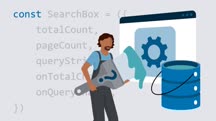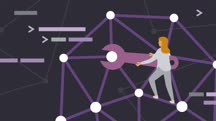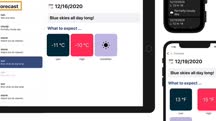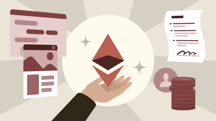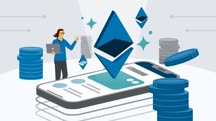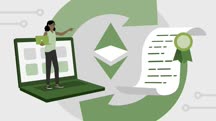Course catalog
Categories
Showing 201-220 of 1,450 items.
Build Your Financial Literacy (214860)
If you’ve ever felt confused by financial decisions you needed to make, or financial documents that you needed to read, this course is for you. Finances are important, but the jargon can be overwhelming. In this course, finance expert Cassandra Reed walks you through dozens of common financial terms. Cassandra shows you how to use these terms comfortably, recognize them in documents, and use them to make smarter financial decisions. She covers calculating your net worth, navigating your personal bank accounts, and making informed choices about investing. Cassandra explains how to identify the differences between common retirement accounts, such as IRA’s and 401(k)’s. Finally, if you’re a small business owner, this course offers you a solid foundation in the documents and terms you need to know to ensure you’re staying profitable. No matter how early you are in your financial journey, this course can help.
This course was created by Madecraft. We are pleased to host this training in our library.

This course was created by Madecraft. We are pleased to host this training in our library.

Building a Cybersecurity Awareness Program: Phishing Simulations (221711)
Security awareness training is essential for any enterprise. But how do you keep employees alert to ever-evolving threats like phishing? In this course, Lauren Zink explores one popular method of raising security awareness: conducting phishing simulations. Whether you have a training program in place or you are trying to start one, this course provides guidance on building tests that can help employees understand the social engineering techniques that hackers use to get them to reveal credentials and proprietary data. Learn how to test your employees by writing realistic phishing emails and use metrics and feedback from the test to grow the program. Lauren explains exactly how to plan, execute, and conclude your test and how to make it a beneficial learning experience for you and your employees.
Building a GraphQL Project with React.js (230823)
Are you a web developer creating apps? GraphQL gives you a clean way to query complex server data efficiently, and React makes it easy to present that information as a web application in the browser. In this course, instructor Ray Villalobos teaches you how to assemble these parts, using the familiar structure of GitHub as a source for information. Ray first walks you through installing React, including how to use the command-line interface (CLI), as well as how to customize and add the node modules you will need for this project. He explores what you can do with the GitHub API using GraphiQL, then shows you how to retrieve data, generate a query component, and more. Ray goes over each step in building the React app, concluding with how to create the pagination interface.
Building a Headless WordPress Site with Gatsby (228171)
WordPress, the powerful publishing platform, powers much of the web. Gatsby allows developers to build performance-focused, modern websites and applications with React. In this course, discover how to combine this dynamic duo to get a web publishing powerhouse. Join instructor Morten Rand-Hendriksen as he explains how to use WordPress to populate a Gatsby site. He shows you the plugins you need to use WordPress data in a Gatsby site, then demonstrates how to connect WordPress and Gatsby. He covers how to create a variety of custom menus, including a nested menu and a footer menu. He demonstrates how Gatsby can be configured to generate new pages based on WordPress posts. Morten goes over how you can query categories and tags, as well as how to generate index pages for each category of the WordPress site. He walks you through how to access custom data through GraphQL and use it in your Gatsby site, then concludes by explaining how to deal with WordPress blocks when working in Gatsby.
Building a Portfolio with Adobe Portfolio (223904)
Adobe Portfolio comes free with any Creative Cloud plan and enables designers to quickly and simply build a website to showcase their creative work. No web design knowledge required! In this course, Rich Harrington provides an overview of Adobe Portfolio, and shows how to create and optimize an online portfolio so it fits your creative style. He shows how to choose a template, customize the site, and import content from Lightroom, Photoshop, Illustrator, and Behance. The course wraps with tips on publishing your portfolio, such as creating a custom domain.
Building a Resilient Web (230330)
Web developers have a wide variety of tools to use and choices to make. How should you mix HTML, CSS, and JavaScript? How do you balance speed and rich media? What happens when third-party content moves or breaks? Join Morten Rand-Hendriksen as he demonstrates how focusing on resilience can help you create web applications that will work for all of your users. First, learn what makes an app or website fragile. Then explore the basic techniques underlying the resilient web, including progressive enhancement, accessibility, link persistence, web components, and more. Next, discover how to avoid issues introduced by JavaScript frameworks. Finally, watch as Morten takes you step by step through the process of architecting a resilient web application, from setting your goals to maintaining your links.
Building a Stellar Employee Experience (216645)
You've probably heard the phrase that employees are the lifeblood of any business—and it's true! Employees who are set up to be successful have a positive impact on the business, so it's important for you to dedicate time towards building positive employee experiences. This is no easy feat. It can be challenging to diagnose what creates positive employee experiences and even more difficult to actually create these experiences. In this course, industrial psychologist and executive coach Mary Kennett equips you with tools to shift focus back to your employees, strategies to recognize what is important to them, and methods to satisfy their workplace needs. Mary empowers you to craft a world class employee experience that will make your organization more successful.
This course was created by Madecraft. We are pleased to host this training in our library.

This course was created by Madecraft. We are pleased to host this training in our library.

Building a Trustworthy Reputation (214282)
Are you trustworthy? Are you sure? Maybe you’ve never given anyone reason not to trust you, but have you given them a reason to trust you? Despite your best efforts and a desire to be trustworthy, there’s no guarantee that that’s how people see you. What’s more, trust can take years to build but only seconds to lose. In this course, Ron Carucci teaches the skills you need to build a solid reputation of trustworthiness. Based on his own research, Ron provides inspiring examples and practical approaches to establish a credible and consistent voice and style that gains trust from others. Ron touches on important topics like speaking your mind and telling difficult truths, supporting teammates in the face of inequity, treating people with dignity and respect, and building bridges and embracing different perspectives. If you want to achieve a life and career of influence and impact, join Ron as he helps you build the foundations you need for others to conclude that you are someone they can trust.
Building a WordPress Membership Site with Ecommerce (218328)
Do you need to implement a membership and ecommerce solution for yourself or a client? Are you looking for guidance on tools you can use to build such a solution? This course from experienced developer and blogger Carrie Dils is just what you need. Carrie gives you an overview of what you will need for this course and the demo project you’ll be building, then defines paid membership sites and project requirements. She explains why this course uses WooCommerce and WooCommerce Memberships. Then Carrie dives right into the steps to set up your site, set up your store, set up and configure memberships and membership plans, and restrict content and products based on membership plans. She shows you ways to manage members and shares some tests you should run before launching your site. Carrie finishes up with a discussion of additional integrations you may need, depending on your project requirements.
Building a WordPress Membership Site: Getting Started (228647)
Do you want to build a membership site with WordPress? Learn how, as instructor Carrie Dils walks you through building a membership site with WordPress and a membership plugin. Carrie explains what a membership site is and what types of membership plugins you can use to build them. She goes over different types of membership plugins and what factors you should consider in finding the best plugin for your needs. Carrie explains the costs of maintaining a membership site, different pricing models, and considerations for billing. She concludes with useful tips on ways to learn more.
Building an App for All Apple Platforms (232795)
Each Apple platform—macOS, iOS, iPadOS, watchOS and tvOS—offers individual capabilities and user experience, yet also integrates tightly to provide a unified feel. In this project-based course, learn how to build an app that will not only run seamlessly across all Apple platforms, but also fit the specific function and UX of each device. In a sample project, discover how to set up a multiplatform template and build user interfaces leveraging a single set of tools and APIs. Consider different navigation requirements for iPhone, iPad, and Mac, and explore the design principles particular to each one. Plus, discover how to write platform-specific and independent code.
Building an Audience on Instagram for Creators (214979)
Maybe you want to be Instagram-famous, or maybe you’d just like to draw some extra attention to a special sale you’re running. Whatever your goals may be, using the right hashtags can help you achieve your goals. This brief course goes over practical techniques to build and retain your audience. To make the best use of hashtags, you need to understand the hashtag algorithm in Instagram and know how many hashtags to use in a post and where to put them. Once you have that figured out, discover how to create your own branded hashtag, how to pick the best hashtags to attract your audience, how to know if your hashtags are working, and more. As a bonus, learn how following and interacting with hashtags can help you gain new followers and keep them more engaged.
Building an Ethereum Blockchain App: 1 Introduction to Blockchain (220453)
What is blockchain technology, and where did it come from? Why are other people using it, and what can it do for you? This series of eleven courses introduces blockchain technologies and deep dives into Ethereum development. In this first course, instructor Michael Solomon explains in-depth what blockchain is. Michael explains the beginning of blockchain and how it differs from Bitcoin. He shows you how blockchain solves common problems in the vendor-customer relationship, then goes into blockchain immutability and consensus. Michael covers what’s contained in the actual blocks of a blockchain story and how the data on the blockchain is linked together. He goes over blockchain mining and the algorithms that nodes use to arrive at consensus and keep the blockchain synced. Michael describes the difference between public blockchains and private ones, then finishes up with how blockchain provides solutions to many issues in distributed processing.
Note: This course was created by Michael Solomon. We are pleased to host this training in our library.
Note: This course was created by Michael Solomon. We are pleased to host this training in our library.
Building an Ethereum Blockchain App: 2 Introduction to Ethereum (220249)
Have you wondered how blockchain can help you create applications that offer greater transparency, traceability, efficiency, and resilience while lowering your costs? This course, second in a series of eleven, introduces you to the history and uses of Ethereum. Instructor Michael Solomon begins with the history and origins of Ethereum, a decentralized, open source blockchain that supports smart contract functionality. Then he goes into the ways Ethereum is used across several industries, including financial services, digital identity management, government, and more. Michael explains the smart contracts that are the heart of what Ethereum does and discusses Ethereum’s native cryptocurrency. He goes over all the parts of the Ethereum ecosystem, including the blockchain itself, the Ethereum Virtual Machine (EVM), wallets, cryptocurrency exchanges, and more. Michael concludes with an explanation of how blockchain apps differ from standard apps.
Note: This course was created by Michael Solomon. We are pleased to host this training in our library.
Note: This course was created by Michael Solomon. We are pleased to host this training in our library.
Building an Ethereum Blockchain App: 3 Ethereum Development (219297)
Have you wondered how blockchain can help you create applications that offer greater transparency, traceability, efficiency, and resilience while lowering your costs? This course, third in a series of eleven, introduces you to everything you need to write and test smart contract code in Ethereum. Instructor Michael Solomon discusses the parts of the Ethereum blockchain, such as of decentralized apps (dApps), blocks, and miners. Michael covers smart contracts, smart contract languages, and the Ethereum Virtual Machine (EVM) that ensures every node on the blockchain keeps the same copy of the blockchain. He explains the concept of fueling your code with gas, then goes into the tools you need to follow the software development life cycle (SDLC) for Ethereum. After describing a blockchain client, Michael concludes by showing you the tools you need to write and test your smart contract code.
Note: This course was created by Michael Solomon. We are pleased to host this training in our library.
Note: This course was created by Michael Solomon. We are pleased to host this training in our library.
Building an Ethereum Blockchain App: 4 Ethereum Development Tools (232710)
Have you wondered how blockchain can help you create applications that offer greater transparency, traceability, efficiency, and resilience while lowering your costs? This course, fourth in a series of eleven, goes in-depth on the tools you need to develop your code. Instructor Michael Solomon walks you through the tools you’ll need from your Ethereum development toolbox, such as the blockchain client (EVM), local and public test blockchains, and more. Michael shows you how to download and install Go Ethereum (Geth), the command-line interface blockchain client. Then he steps through installing Ganache, the test blockchain that you will use in this course; Truffle, the development environment and testing framework; and Microsoft Visual Studio Code, a free integrated development environment (IDE).
Note: This course was created by Michael Solomon. We are pleased to host this training in our library.
Note: This course was created by Michael Solomon. We are pleased to host this training in our library.
Building an Ethereum Blockchain App: 5 Your Ethereum Wallet (219280)
Have you wondered how blockchain can help you create applications that offer greater transparency, traceability, efficiency, and resilience while lowering your costs? This course, fifth in a series of eleven, goes in-depth on how to create an Ethereum wallet. Instructor Michael Solomon first explains what an Ethereum wallet is and how it keeps your cryptoassets safe. Then he goes over types of Ethereum wallets, including hardware and software, hot and cold, web and desktop, and more. Michael digs deeper into mobile, hardware, and paper wallets and reviews some of the popular types. He finishes by showing you how to install MetaMask, a simple browser wallet that enables you to interact with public test blockchains and the mainnet.
Note: This course was created by Michael Solomon. We are pleased to host this training in our library.
Note: This course was created by Michael Solomon. We are pleased to host this training in our library.
Building an Ethereum Blockchain App: 6 Building Your First Ethereum App (219263)
Have you wondered how blockchain can help you create applications that offer greater transparency, traceability, efficiency, and resilience while lowering your costs? This course, sixth in a series of eleven, walks you through building your first Ethereum app in Truffle, using the Solidity programming language. Instructor Michael Solomon shows you how to create and initialize a new directory for your Truffle project, launch Microsoft Visual Studio Code, and configure the Truffle project files. He steps you through writing and compiling a simple smart contract with the Solidity programming language. Michael also covers how to hook up your development environment to a test blockchain and deploy your smart contract to the test blockchain.
Note: This course was created by Michael Solomon. We are pleased to host this training in our library.
Note: This course was created by Michael Solomon. We are pleased to host this training in our library.
Building an Ethereum Blockchain App: 7 Smart Contracts (219246)
Have you wondered how blockchain can help you create applications that offer greater transparency, traceability, efficiency, and resilience while lowering your costs? This course, seventh in a series of eleven, goes in-depth on smart contracts. Instructor Michael Solomon reviews what smart contracts are, then takes you through some real world examples of blockchain solutions being used today. Michael goes over some supply chain challenges and how blockchain solves them in a unified way. He explains the payment system that Ethereum tokens represent. Then Michael dives into your supply chain project: what it will look like, what programming language you will use, what data types you will use, and how to define them. He briefly revisits the concept of gas and how it is calculated and used, then concludes with helpful explanations of controlling flow and handling errors.
Note: This course was created by Michael Solomon. We are pleased to host this training in our library.
Note: This course was created by Michael Solomon. We are pleased to host this training in our library.
Building an Ubuntu Server (219943)
Building and hosting your own server at home or in the office is a great way to learn about system configuration and administration, and also provides an opportunity to maintain control of your files and services. Servers are often used to provide services like file sharing and web hosting, and can be used for running containers, virtual machines, and other development tools. In this course, Scott Simpson demonstrates how to set up a Linux server using Ubuntu, and provides an introduction to system administration. He discusses storage and network configuration, gives advice on what kind of hardware to use, and surveys popular services that home and business users frequently require. At the end of this course, you’ll have the tools and knowledge to build a working server of your own.


